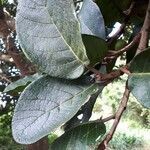Large or small buttressed trees, 8-40 m. tall. Twigs 2-6 mm. in diameter, generally glabrous, with a thin reddish or greyish brown periderm. Stipules 30-125 mm. long, narrowly deltoid, generally glabrous. Lamina 2-11 cm. wide X 5-25 cm. long, lanceolate to broadly elliptic, essentially glabrous, generally glossy above, sometimes slightly inequilateral; apex blunt or acute, to acuminate; base cuneate, round cuneate, rounded or emarginate; lateral veins 10-25 [-30] pairs, departing from the midrib at an angle of 400 or less; basal veins departing from the midrib at an angle from 300-600; intercostals slightly prominent. Petiole 10-65 mm. long, 1/3-1/S the length of the lamina, the epidermis not exfoliating, though frequently wrinkled. Figs 15-30 mm. in diameter, globose with or with-out a stalk above the basal bracts, 1-6 mm. long, glabrous or pubescent, borne among the leaves; color green or yellowish-green; peduncle 3-22 mm. long, thin or stout; basal bracts three, 1-3 (-5) mm. long, deltoid or semicircular; orifice flat, or somewhat crateriform or mammillate, 2-4 mm. in diameter, 1-2 mm. high.
More
A fig. It is a large tree. It has buttresses. the bark is smooth and grey brown. The leaves are bright shiny green with yellow veins. The fallen leaves turn bright yellow. There is a circular scar at the base of each leaf. Broken leaves drip white latex. The flowers and fruit are inside the fig balls. The flowers are pollinated by wasps.
Forest or open fields or hillsides, often along roadsides, frequently near habitations, usually at low elevations, but ranging from sea level to elevations of about 1,400 metres. Found in wet evergreen and seasonally dry deciduous forest.
More
It is a tropical plant. It grows in open areas.
The latex is used commercially as a meat tenderiser, and in edible collagen films, sausage casings and in chillproofing beer. It is also used in curdling milk for cheese. The fruit are eaten.







